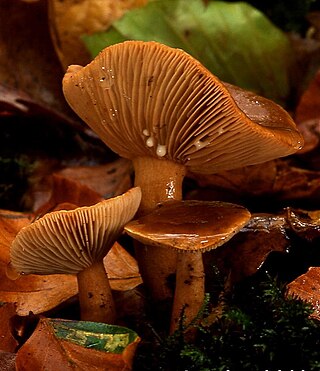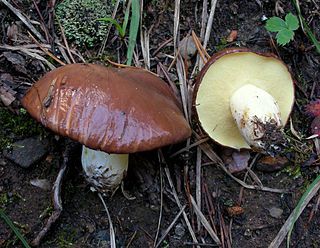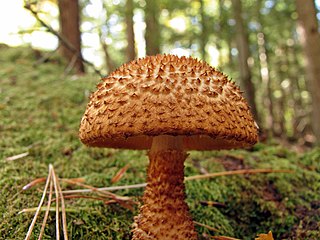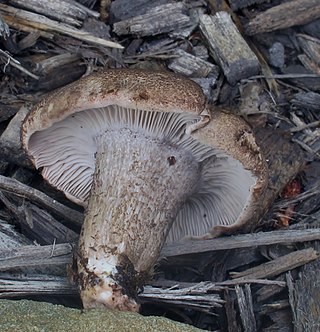
The Agaricaceae are a family of basidiomycete fungi and include the genus Agaricus, as well as basidiomycetes previously classified in the families Tulostomataceae, Lepiotaceae, and Lycoperdaceae.

In mycology, a lamella, or gill, is a papery hymenophore rib under the cap of some mushroom species, most often agarics. The gills are used by the mushrooms as a means of spore dispersal, and are important for species identification. The attachment of the gills to the stem is classified based on the shape of the gills when viewed from the side, while color, crowding and the shape of individual gills can also be important features. Additionally, gills can have distinctive microscopic or macroscopic features. For instance, Lactarius species typically seep latex from their gills.

Suillus luteus is a bolete fungus, and the type species of the genus Suillus. A common fungus native all across Eurasia from Ireland to Korea, it has been introduced widely elsewhere, including North and South America, southern Africa, Australia and New Zealand. Commonly referred to as slippery jack or sticky bun in English-speaking countries, its names refer to the brown cap, which is characteristically slimy in wet conditions. The fungus, initially described as Boletus luteus by Carl Linnaeus in 1753, is now classified in a different fungus family as well as genus. Suillus luteus is edible, though not as highly regarded as other bolete mushrooms. It is commonly prepared and eaten in soups, stews or fried dishes. The slime coating, however, may cause indigestion if not removed before eating. It is often sold as a dried mushroom.

The Hygrophoraceae are a family of fungi in the order Agaricales. Originally conceived as containing white-spored, thick-gilled agarics, including Hygrophorus and Hygrocybe species, DNA evidence has extended the limits of the family, so it now contains not only agarics, but also basidiolichens and corticioid fungi. Species are thus diverse and are variously ectomycorrhizal, lichenized, associated with mosses, or saprotrophic. The family contains 34 genera and over 1000 species. None is of any great economic importance, though fruit bodies of some Hygrocybe and Hygrophorus species are considered edible and may be collected for sale in local markets.

Hygrophorus is a genus of agarics in the family Hygrophoraceae. Called "woodwaxes" in the UK or "waxy caps" in North America, basidiocarps are typically fleshy, often with slimy caps and lamellae that are broadly attached to decurrent. All species are ground-dwelling and ectomycorrhizal and are typically found in woodland. Around 100 species are recognized worldwide. Fruit bodies of several species are considered edible and are sometimes offered for sale in local markets.

Entoloma sinuatum is a poisonous mushroom found across Europe and North America. Some guidebooks refer to it by its older scientific names of Entoloma lividum or Rhodophyllus sinuatus. The largest mushroom of the genus of pink-spored fungi known as Entoloma, it is also the type species. Appearing in late summer and autumn, fruit bodies are found in deciduous woodlands on clay or chalky soils, or nearby parklands, sometimes in the form of fairy rings. Solid in shape, they resemble members of the genus Tricholoma. The ivory to light grey-brown cap is up to 20 cm (7.9 in) across with a margin that is rolled inward. The sinuate gills are pale and often yellowish, becoming pink as the spores develop. The thick whitish stem has no ring.

Entoloma is a genus of fungi in the order Agaricales. Called pinkgills in English, basidiocarps are typically agaricoid, though a minority are gasteroid. All have salmon-pink basidiospores which colour the gills at maturity and are angular (polyhedral) under a microscope. The genus is large, with almost 2000 species worldwide. Most species are saprotrophic, but some are ectomycorrhizal, and a few are parasitic on other fungi. The type, Entoloma sinuatum, is one of several Entoloma species that are poisonous, typically causing mild to severe gastrointestinal illness.

Suillus brevipes is a species of fungus in the family Suillaceae. First described by American mycologists in the late 19th century, it is commonly known as the stubby-stalk or the short-stemmed slippery Jack. The fruit bodies (mushrooms) produced by the fungus are characterized by a chocolate to reddish-brown cap covered with a sticky layer of slime, and a short whitish stipe that has neither a partial veil nor prominent, colored glandular dots. The cap can reach a diameter of about 10 cm, while the stipe is up to 6 cm long and 2 cm thick. Like other bolete mushrooms, S. brevipes produces spores in a vertically arranged layer of spongy tubes with openings that form a layer of small yellowish pores on the underside of the cap.

Callistosporium is a genus of fungi in the order Agaricales. Basidiocarps are agarics, either with a central stipe (stalk) or pleurotoid. The latter group were formerly referred to Pleurocollybia. Recent molecular research, based on cladistic analysis of DNA sequences, has shown that the genus is a natural, monophyletic grouping, though not all species have yet been sequenced. Species are saprotrophic, typically growing on wood, and the genus is found worldwide.
Pleurocollybia is a genus of fungi in the family Callistosporiaceae. Basidiocarps are pleurotoid and grow on wood. DNA research has shown that the type species, P. praemultifolia belongs in the genus Callistosporium, making Pleurocollybia a synonym. Not all species have been investigated, however, and it is not clear that every Pleurocollybia species belongs in Callistosporium. Pleurocollybia cibaria has, for example, been transferred to the genus Gerhardtia.

Gymnopilus subtropicus is a species of agaric fungus in the family Hymenogastraceae.

Leucopholiota decorosa is a species of fungus in the mushroom family Tricholomataceae. Commonly known as the decorated pholiota, it is distinguished by its fruit body which is covered with pointed brown, curved scales on the cap and stem, and by its white gills. Found in the eastern United States, France, and Pakistan, it is saprobic, growing on the decaying wood of hardwood trees. L. decorosa was first described by American mycologist Charles Horton Peck as Agaricus decorosus in 1873, and the species has been transferred to several genera in its history, including Tricholoma, Tricholomopsis, Armillaria, and Floccularia. Three American mycologists considered the species unique enough to warrant its own genus, and transferred it into the new genus Leucopholiota in a 1996 publication. Lookalike species with similar colors and scaly fruit bodies include Pholiota squarrosoides, Phaeomarasmius erinaceellus, and Leucopholiota lignicola. L. decorosa is considered an edible mushroom.

Cystodermella cinnabarina is a basidiomycete fungus of the genus Cystodermella. Its fruiting body is a small agaric bearing a distinctive reddish-coloured grainy cap. It occurs in coniferous and deciduous forests throughout the world. Prior to 2002, this species belonged to genus Cystoderma, subsection Cinnabarina, under the name Cystoderma cinnabarinum which is still sometimes applied. Another often used synonym is Cystoderma terreyi.

Amanita atkinsoniana, also known as the Atkinson's amanita, is a species of fungus in the family Amanitaceae. The fruit body is white to brownish, with caps up to 12.5 centimetres in diameter, and stems up to 20 cm long. The surface of the cap is covered with brownish conical warts.

Catathelasma imperiale, also known as Catathelasma imperialis, and commonly known as the imperial mushroom, Hutsul mushroom, or korban, is a species of agaric in the family Biannulariaceae. Basidiocarps are stocky, with a double annulus (ring), and a tapering to rooting stipe (stem). The species is ectomycorrhizal with conifers and is found in continental Europe and Asia. Reports from North America are unconfirmed and may refer to Catathelasma evanescens or similar species. Fruit bodies are edible and collected for food in China and elsewhere. The species is widespread but uncommon and is assessed as globally "near threatened" on the IUCN Red List of Threatened Species.

Roridomyces austrororidus, commonly known as the austro dripping bonnet, is a species of agaric fungus in the family Mycenaceae. Described as new to science in 1962 by American mycologist Rolf Singer, it is found in South America, New Zealand, and Australia, where it grows on rotting wood.

Amanita augusta is a small tannish-brown mushroom with cap colors bright yellow to dark brown and various combinations of the two colors. The mushroom is often recognizable by the fragmented yellow remnants of the universal veil. This mushroom grows year-round in the Pacific Northwest but fruiting tends to occur in late fall to mid-winter. The fungus grows in an ectomycorrhizal relationship with hardwoods and conifers often in mixed woodlands.

Pseudotricholoma is a genus of fungi in the family Tricholomataceae. The genus contains three species known from North America. Europe, and the Azores. Basidiocarps resemble those of the genus Tricholoma, with a dry fibrillose pileus and white to brown lamellae that have adnate to emarginate attachment and stain reddish when damaged, eventually turning black. Microscopically, the basidiospores are smooth, ellipsoid to ellipsoid-oblong, thin-walled and amyloid. Cheilocystidia are rare to absent and pleurocystidia are absent. The pileipellis is a cutis and clamp connections are present. Species in Pseudotricholoma are found on soil in grasslands and woods. They are probably biotrophic, and may be ectomycorrhizal.
Pseudotricholoma metapodium is a species of agaric in the family Tricholomataceae. It has been given the recommended English name of mealy meadowcap. The species has a European distribution, occurring mainly in agriculturally unimproved grassland. Threats to its habitat have resulted in the mealy meadowcap being assessed as globally "endangered" on the IUCN Red List of Threatened Species.

Pleurotus parsonsiae, also known as velvet oyster mushroom, is a species of edible fungus in the genus Pleurotus, endemic to New Zealand.

















